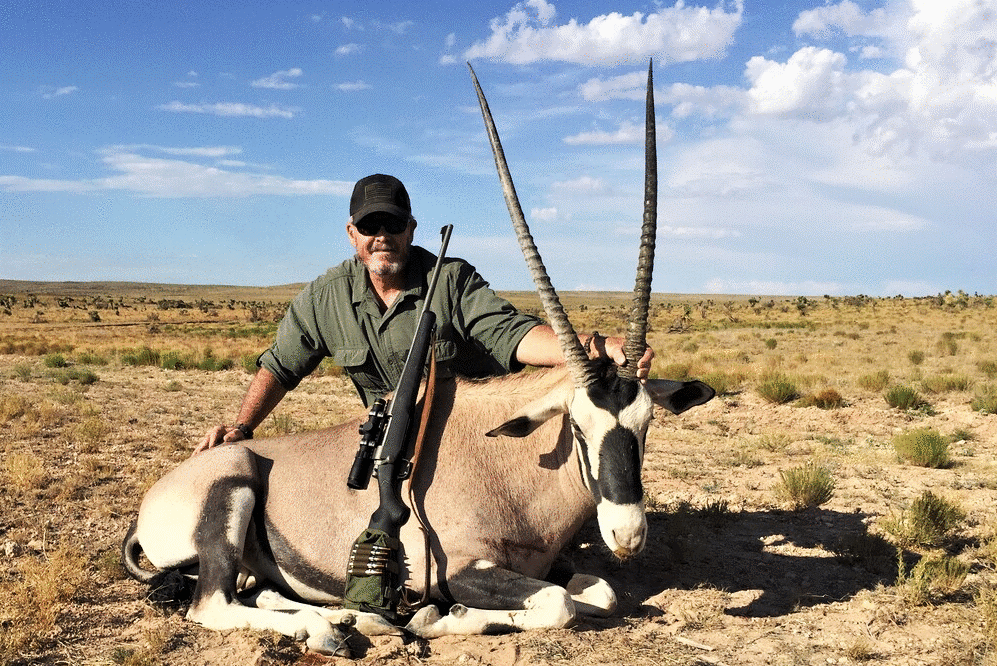For hunters looking to add to their diversity of big game species hunted and can’t afford a trip to Africa, Asia or Europe there does exist an “at home” option. Nor does this option involve high fences plus thousands of dollars in trespass fees or trophy.
New Mexico as you may know offers hunts for three premier big game species within its borders that are all completely free range and will guarantee the hunt of a life time. The only caveat…hunting is hunting and there are certainly no absolutes when pursuing any free range game animal.
These three exotics include, Oryx or Gemsbok, Barbary Sheep or Aoudad, and Persian Ibex. New Mexico Department of Game and Fish (NMDGF) experimented with the introduction of these species many years ago within the state. The end result was hunting opportunities for theses exotics became a reality.
Let’s take a closer look at each species and hunting options.
Oryx
The Oryx found in New Mexico are native to the Kalahari region of south-central Africa and offer a wonderful hunting opportunity for any sportsman. Several options exist to acquire an oryx license in New Mexico. The first being the online public draw system via the NMDGF application process with dozens of different oryx hunts and dates being available. Most high-quality public hunts occur on WSMR, also known as big game unit 19 in southcentral New Mexico. Because this area is a military reservation additional rules and fees apply.
New Mexico offers year-round, monthly hunts by the public draw system outside of the higher demand hunt areas of WSMR. These hunts are in place to keep Oryx numbers in check.
Private land over-the-counter licenses are also available to hunt private land only with written permission of landowner, but be prepared to pay a trespass fee. There are very specific laws and licensing requirements for these hunts, and some advance study regarding them is necessary.
Where Oryx exist, you may find them in grasslands typically considered pronghorn habitat all the way into rocky foothills where you would expect to find deer. Oryx can survive long periods without direct water by getting moisture from plants and vegetation on which they feed, but of course utilize water when available especially in hotter months.
Hunting Oryx is generally a spot and stalk approach. Plan on lots of glassing with quality optics from high land points if they exist and then making a stalk. Normally, oryx are found in a herd of a dozen or more but it is not uncommon to find singles. When alarmed, you will observe tail swishing, their tails being not unlike a horse tail. Expect a quick departure by the animal when you see this behavior. Both sexes have horns that can be up to 42 inches in length and occasionally even longer.
An adult oryx can weigh in the 400 to 500-pound range and are renowned for being tough to bring down if shot placement is poor.
You will need to rethink your normal aiming point that you would use on say, a deer once you find an Oryx in the field. Oryx vitals, in fact all African Big Game, lay further forward in the chest cavity, therefore if the quarry is broadside to the hunter, the target area is directly through instead of behind the shoulder.
Having seen them take a lot of punishment from high caliber rifles and still not go down, my recommendation is a larger caliber rifle along the lines of 30-06, 300 Winchester magnum or the like that you are confident in and shoot well. During a recent hunt, I took a nice bull using the Ruger .375 cartridge in the Mossberg Patriot rifle and it performed wonderfully.
Oryx are a striking trophy with their contrasting black and white facial markings and long black horns and are excellent when it comes to table fare. They can be very challenging to hunt, especially in fringe areas of their primary range in NM. Another obvious plus, if you can’t afford an African safari, you can surely afford a trip to New Mexico.
Barbary Sheep
Barbary Sheep, also known as aoudad, have become a highly sought-after exotic big game animal within the US. Native to several countries of Northern Africa, they are also found in the Southwestern US, primarily Texas and New Mexico, where they have been introduced as an exotic game animal.
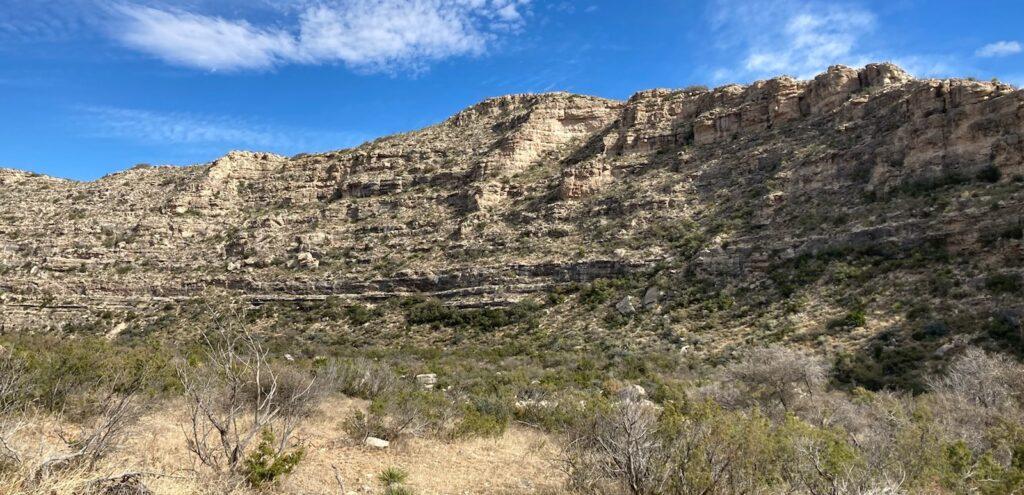
Excellent Barbary Sheep Habitat
In New Mexico, Barbary Sheep were introduced in the 1940s on a private ranch and again in the 1950s by New Mexico Department of Game & Fish. These sheep can weigh over 300 pounds and are notoriously tough, agile, and adaptable preferring rocky and precipitous terrain where they often elude predators and hunters alike. They are extremely nomadic and travel constantly via mountain ranges and corridors. However, I have seen them down in flat desert areas consisting of little more than creosote and catclaw.
As with most all big game hunting, quality optics are essential. Use of a spotting scope on the rugged canyon walls that these sheep like to frequent will not only assist you in locating them, but also to discern trophy quality. Recently I have been putting the new Riton 5 Rimal spotting scope to the test. Offering 15-45x magnification with a 60mm objective, the Riton is optimal for this type of glassing.
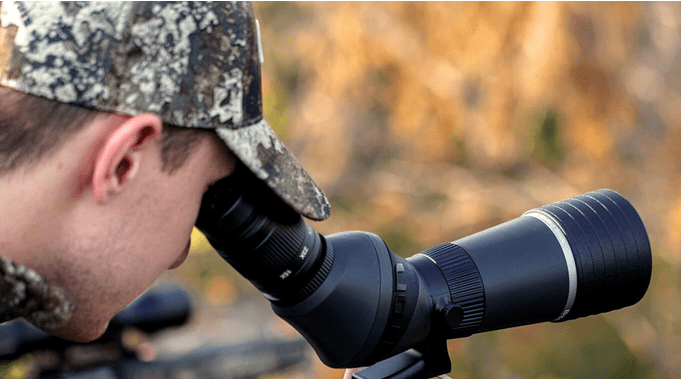
Riton Optics New Spotting Scope: Riton 5 Rimel
Mature rams sport a mane of sorts that extends from the throat area down the chest and then along the front legs, often referred to as chaps. A mature trophy ram will sport horns from around 25 inches to well over 30 inches with some exceeding 35 inches in length.
Licenses to hunt Barbary Sheep in New Mexico can be obtained one of two ways. First, via the public draw system conducted in the spring of each year. Or secondly, via a private land carcass tag purchased directly from a license vendor. This option requires having written permission from the landowner and hunting only on the owner’s private property during an existing Barbary season much like the Oryx system mentioned above.
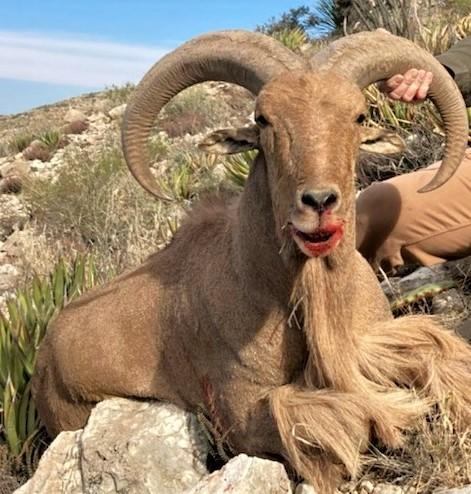
A Nice Barbary Ram
As to table fare, older mature rams can be tough, but the flavor is very mild and will make excellent hamburger or sausage. One of my favorite rifles for Aoudad includes the Bergara Hunter model in calibers ranging from the .270 Winchester to .300 Winchester Magnum as you may find shots across canyons at longer distances.
No matter where or how you choose to hunt Aoudad, they are a challenge, good table fare and a handsome trophy.
Persian Ibex
Ibex came to inhabit the Florida Mountains (pronounced as Floor-ee-da) of southwestern New Mexico in 1970 after the Department of Game and Fish imported around 45 of the animals from Iran. By 1974, the Department held its first ibex hunt for the public and currently these hunts are usually conducted in the fall of each year.
Most license for the Ibex in New Mexico is through the public draw system, however unlimited license are available in zones outside of the main Florida Mountains for population control.
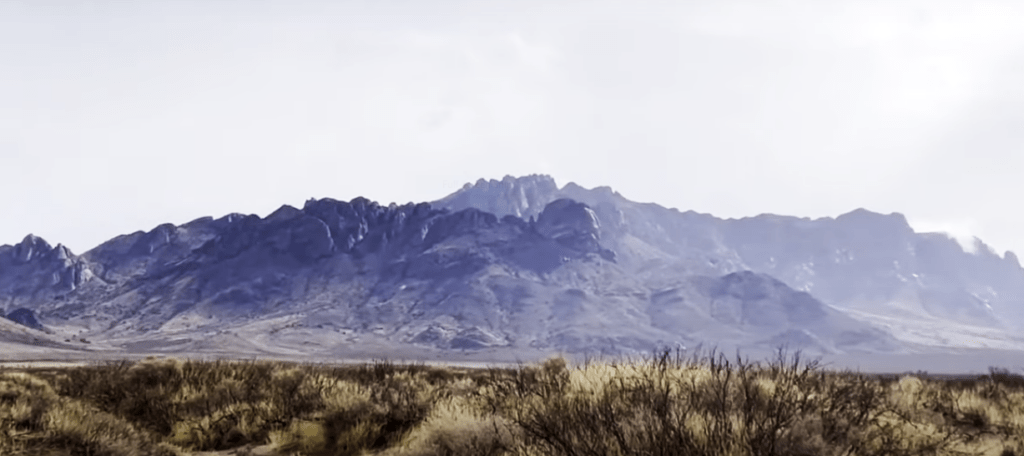
Florida Mountains of SW New Mexico is home to the Persian Ibex
The climb to the peaks of the Florida Mountains, near Deming, New Mexico will challenge any hunter and are perfect habitat for Ibex. These cliffs and canyons mirror the home range of Ibex in Iran and rise upward to 7500 feet. The agility of these animals to scale almost sheer cliff walls is legendary and makes this one of the toughest hunts in North America.
Strategies for hunting ibex are first and foremost quality optics and lots of glassing. Both a high magnification spotting scope along with good binoculars will be critical to scan the rugged peaks and cliff faces of the Florida Mountains. The mature bucks or billies, as they are sometimes called, have an almost white coat in the winter months and having the sun at your back when glassing will be to your advantage. Once you spot your quarry, getting into a position for a shot may prove a challenge and thought must be given as to where the Ibex may fall.
I know of cases where hunters were required to hire a technical climbing expert to retrieve their Ibex via rappelling gear when the animal became stuck on some vertical cliff face a hundred feet or more from the bottom of the canyon below. Oh, and be sure to watch for rattlesnakes during the whole process.
A mature billy can weigh up to 150 pounds and have horn lengths of over 50 inches. Any Ibex that hits the 35 inch and above is a very respectable animal and while the females do have horns, they seldom exceed 10 inches. Adult Ibex stand about 30 inches at the shoulder.
It has been about 40 years since I last set foot on the Florida Mountains to hunt Ibex when in my mid-20’s and I can assure you it was a physical challenge even then. In other words, be in as good of physical condition as possible. I utilized my old Remington Model 700 in 30-06 back then and did harvest a respectable billy.
If I were hunting today, I would probably choose a flatter shooting cartridge, light weight rifle. The Christensen Arms Mesa FFT comes to mind weighing in at 5.5 pounds with a wide range of chamberings including the new PRC calibers such as the 6.5 PRC or the 7mm PRC. I recently used the Mesa FFT in 300 Win Mag on a South Arican Plains Game hunt and was pleased.
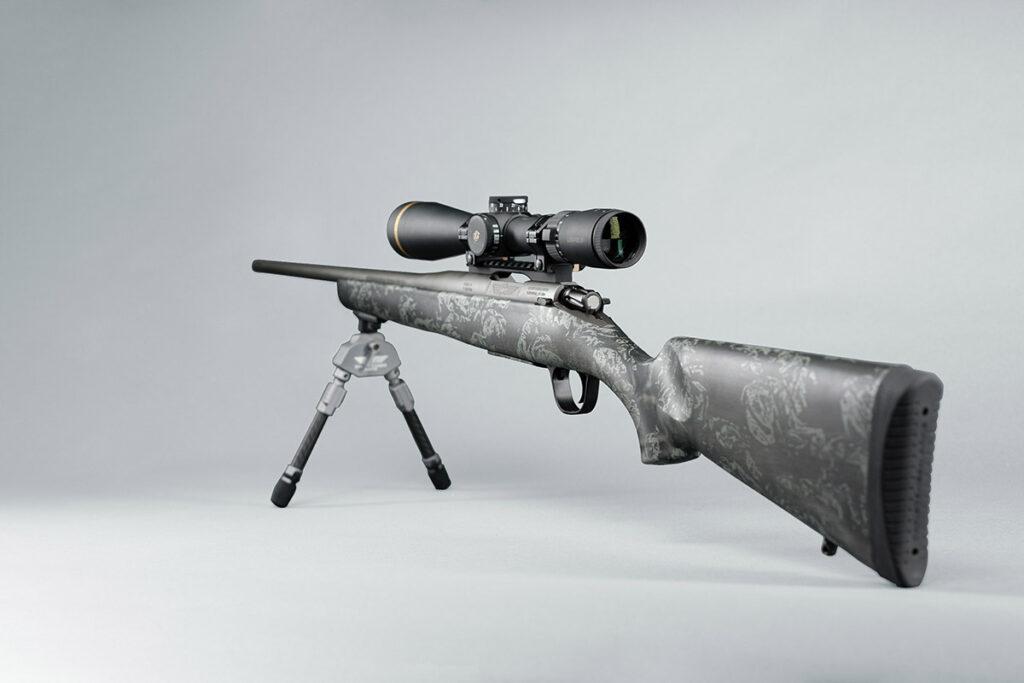
MESA FFT from Christensen Arms
Having specific ballistic data on your elevation and windage adjustments out to 600-800 yards would be a good idea. Cross winds on the mountain can of course be a huge factor.
Archery hunters, well my hats off to you if can manage to collect any Persian Ibex with your bow. Few have succeeded, but some do. No matter what method you choose to pursue Ibex, you are guaranteed to have one of the most challenging hunts of your life.
Controversy has surrounded the exotic program in New Mexico over the years from an eco-biological standpoint. However, I believe it has been one of the greatest hunting success stories for sportsmen in the last half century within the US. All of these species provide for a unique hunting experience that few would otherwise be able to experience. For more information on hunting the exotics of New Mexico go to wildlife.state.nm.us.
To locate a dealer near you please visit www.lipseys.com/dealerfinder
About the Author:
TERRY NELSON – is a 30-year veteran of law enforcement with police and sheriff agencies, including SWAT and sniper roles, and has served as a state game warden. Nelson also served seven years with New Mexico State Guard. A lifelong hunter, guide, tracker and firearms enthusiast, Terry is sought for training in multiple disciplines by both civilian and police-serving agencies and companies. Nelson also holds a Basic Tac Med instructor certification from Federal Law Enforcement Training Center.

